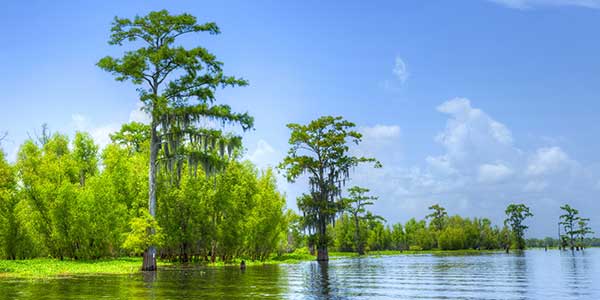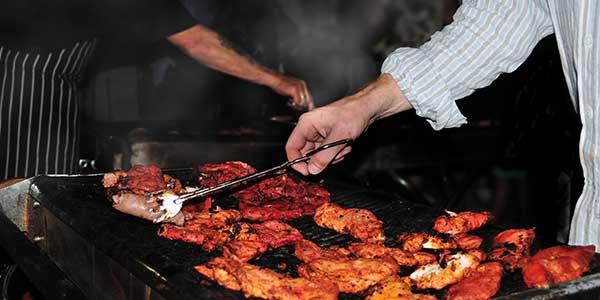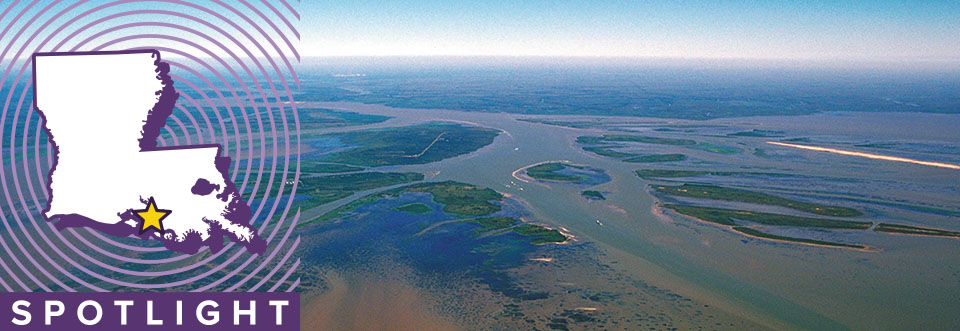Cajun Coast/St. Mary Parish
Go with the flow of endless rivers and bayous
Moss-covered cypress trees, historic towns and the unparalleled flavors of Cajun cuisine entice visitors to this southwest region of Louisiana. Characterized by countless rivers, bayous and lakes, the star attraction here are the Atchafalaya Basin and bayou Tech, vast stretches of unspoiled land.
A ‘Foreign’ Land
The Atchafalaya Basin is the nation’s largest river swamp, containing almost 1 million acres of bottomland hardwoods, swamps, bayous and lakes. Located in the basin’s southern end, the Cajun Coast is an ideal launching point for the area’s explorations. Explore the vast stretch of varied terrain and enjoy great fishing (fresh and saltwater) as well as hunting year-round. The region sits in the path of the Mississippi Flyway, used by some 400 species of native and exotic birds.
Airboats can take you on a tour of the swamps and other natural habitats, where alligators, black bears and nearly 100 species of fish swim. Check out the many Cajun Coast paddling trails that await explorers on a self-guided tour.
Also in the area, the Bayou Tech National Wildlife Refuge dazzles with its profusion of fauna. Established to protect the American black bear, the refuge encompasses 9,028 acres of wet bottomland hardwood forest laced with bayous and canals. It provides habitat for fish and wildlife species such as wading birds, neo-tropical songbirds, waterfowl, reptiles and amphibians, as well as a place for environmental education and public recreation. Visitors can enjoy hunting, fishing, hiking, boating, canoeing and kayaking and wildlife watching on the Bayou Teche NWR Boardwalk and Palmetto Trail.

Morgan City, Franklin and Beyond
About 90 miles west of New Orleans, Morgan City was built by industrialists who took advantage of its location near the Gulf of Mexico and on the Atchafalaya River. Morgan City also became a strategic focal point during the Civil War.
Hollywood showed up beginning in 1917, when the area became a filming location for the first “Tarzan” movie. Actors Peter Fonda and Dennis Hopper crossed a local bridge during their iconic motorcycle ride in 1969’s “Easy Rider.” Today, Morgan City, formerly known as Tiger Island, enjoys a seawall and historic district right along its riverfront. At various points, you can climb stairs to the top of the sea wall for eye-opening views of the Atchafalaya River, which bustles with shrimp boats, barges and other vessels.
Explore the history of Louisiana’s oil industry by climbing aboard a real-life oil rig at the International Petroleum Museum and Exposition. If you’d rather know more about the state’s famous po’boy sandwich, Morgan City can accommodate your curiosity — and your appetite. Take your pick from any one of several restaurants specializing in this delicious cuisine, which may be stuffed with either Gulf Coast seafood or sausage or barbecue pulled pork or… well, you get the idea. One whiff from the many Cajun cuisine-inspired restaurants will compel you to make reservations for a delicious lunch or dinner.

Cajun Cuisine on Offer
Speaking of food, special events featuring Cajun cuisine launch year-round throughout the Cajun Coast. Some summer favorites include the Bayou BBQ Bash/Morgan City Under the Bridge, which is literally held under the bridge of U.S. Highway 90 in town in July. Just how many ways are there to cook one of Louisiana’s favorite shellfish? Find out at the annual Louisiana Shrimp & Petroleum Festival in September, a tradition for nearly a century.
In Franklin, 20 miles to the west of Morgan City, sugar is king. The town’s sugar industry was well-established by the early 1800s, and the area’s architectural flair is seen through the more than 400 landmark structures that make up the Franklin Historic District, listed among the National Register of Historic Places. Franklin’s sugar-cane planters spent a great deal of their wealth on stately mansions and homes, many of which are on East Main Street, where you’ll notice oak trees and turn-of-the-century cast-iron street lamps marking the way to these antebellum gems. Set aside time to tour the following estates:
• Oaklawn Manor. Situated in a vast live oak grove, this colossal Greek Revival showplace of the South was built in 1837 by Alexander Porter, a native of Ireland and a distinguished Louisiana statesman. The walls of this monumental building are 20 inches thick. Henry Clay, a Civil War officer who later rose to become governor of Louisiana, visited Oaklawn in 1842.
• Grevemberg House. This impressive Greek Revival townhouse was built in the 1850s by attorney Henry C. Wilson. It’s now the St. Mary Parish Museum and owned by the City of Franklin. Grevemberg is entrusted to the St. Mary Chapter, Louisiana Landmarks Society, which has effected a major restoration.
• Shadowlawn. This striking Greek temple was built chiefly of northern pine in 1833 by Simeon Smith. Shadowlawn remained in the Smith-Berwick-Snowden family for a century and a half. Recently, the home was meticulously restored by the late Dr. Mildred Christian. In 2011 it was donated to the St. Mary Chapter of the Louisiana Landmarks Society by Dr. Alan Hoberman.
History and Lady Luck: Two for one
You’ll find the Cajun Coast’s Native American heritage preserved at the Chitimacha Museum in Charenton. The museum tells the history of these first inhabitants of the Atchafalaya Basin area. More than 300 tribal members remain on the Chitimacha Reservation, where you’ll also find the Cypress Bayou Casino, Louisiana’s first land-based casino.
For More Information
Cajun Coast Visitors & Tourism Bureau
800-256-2931
www.cajuncoast.com
Louisiana Office of Tourism
800-677-4082
www.louisianatravel.com




